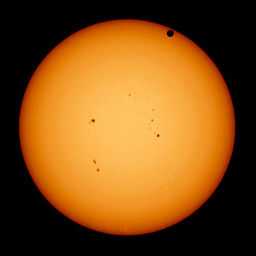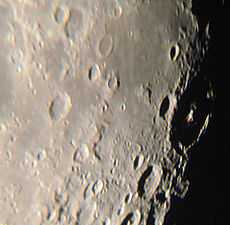Registax
| Developer(s) | Cor Berrevoets |
|---|---|
| Stable release | 6.1.08 / 6 May 2011 |
| Written in | Delphi 2006 |
| Operating system | Windows |
| Available in | English |
| Type | Astronomy software |
| License | Freeware |
| Website |
RegiStax is image processing software for amateur astrophotographers, released as freeware, which runs under Windows.[1][2][3]
Its purpose is to produce enhanced images of astronomic observations through combining consecutive photographs (an image "stack") of the same scene that were taken over a short period of time. The process relies on the subject (e.g. a planet) being unchanged between photographs, so that any differences can be assumed to be random noise or atmospheric interference.
The stack of images can be in the form of individual consecutive shots or from frames of a movie camera trained on the scene.[4][5]


History
Cor Berrevoets (Netherlands) began development of the program about 2001,[6] and it was released on 19 May 2002.[7] This initial release (version v1.0.0) had facilities for stack alignment, grading and selection of the images to be merged, and image enhancement using techniques such as wavelet processing.[8][9] The program was regularly updated by its author and on 6 June 2004 a multi-lingual version was begun (v3) and the program was later available in 15 different languages.[10] To date (May 2013) the latest release is v6.1.0.8 (6 May 2011) which was contributed to by a team of 9 people.[6]
See also
| Wikimedia Commons has media related to Created with Registax. |
- Shift and add image processing technique
- Speckle imaging
- Lucky Imaging
References
- ↑ Vandevenne, Pierre (2003-04-16). "Digital Astrophotography Beginner's Guide - Article". Retrieved 2013-05-26.
Registax (by Cor Berrevoets) offers the best lunar and planetary results in a very easy to use package.
- ↑ Mobberley, Martin (2006). Lunar and Planetary Webcam User’s Guide. Springer. p. 89.
The package that emerged head and shoulders above the compeditors was written by a Dutchman, Cor Berrevoets and is called Registax.
- ↑ Zawodny, Joe (2008-11-15). "Joe Zawodny » RegiStax vs AviStack". Retrieved 2013-05-26.
RegiStax has been around for a long time and is probably the single reason why amateur astronomy has made huge strides in the last several years.
- ↑ Mobberley, Martin (2006). Lunar and Planetary Webcam User’s Guide. Springer. p. 89.
- ↑ Wiley, Keith; Chambers, Steve (2005). "Long-Exposure Webcams and Image Stacking Techniques". Digital Astrophotography: The State of the Art. Springer. pp. 45–60.
- ↑ 6.0 6.1 Berrevoets, Cor. "RegiStax- Free image processing software". Retrieved 2013-05-24.
- ↑ Berrevoets, Cor (2002). "Download". Archived from the original on 2002-08-12.
- ↑ Berrevoets, Cor (2002). "Registax". Archived from the original on 2002-06-09.
- ↑ Vandevenne, Pierre (2003-04-16). "Digital Astrophotography Beginner's Guide - Article".
- ↑ Berrevoets, Cor (2004). "Registax". Archived from the original on 2004-12-08.